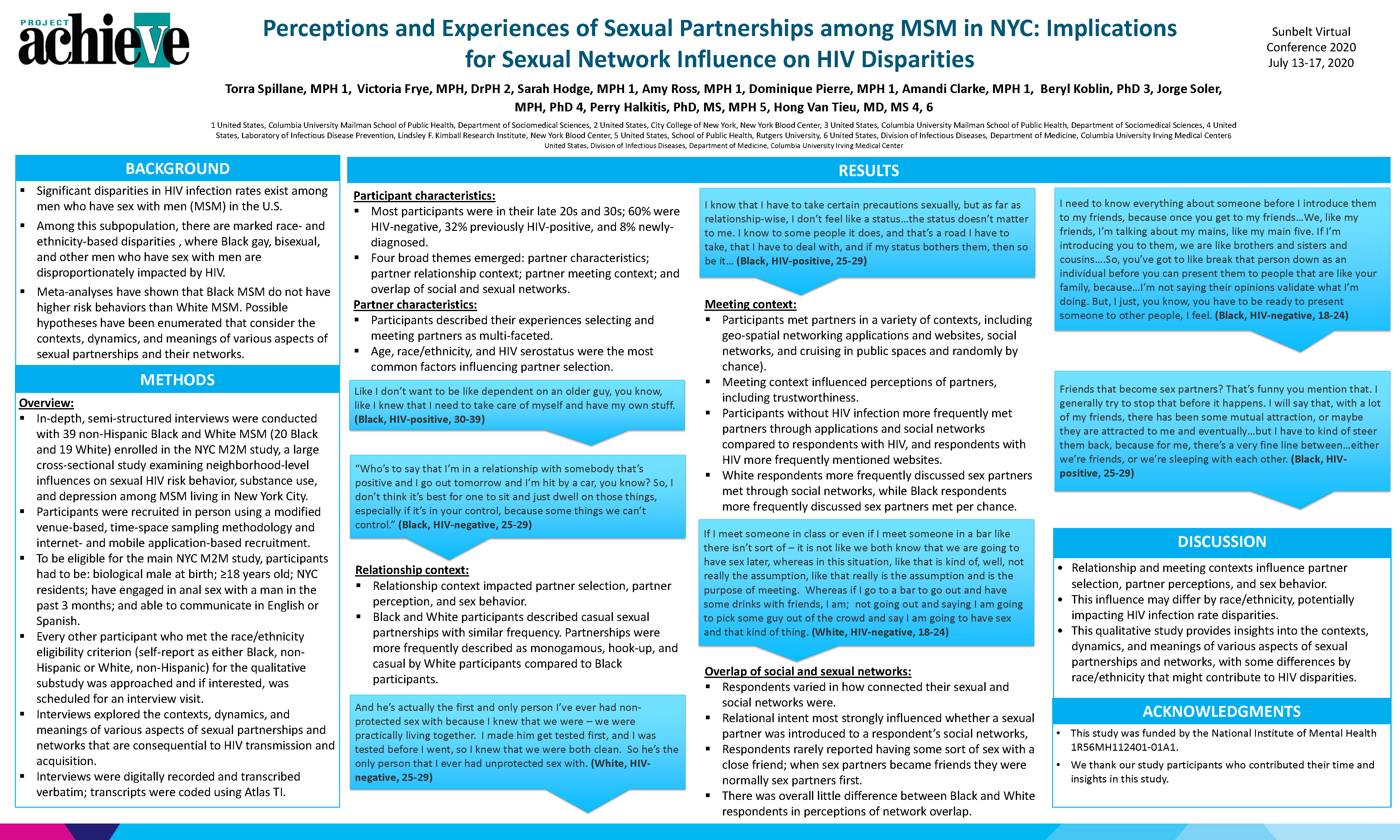
Perceptions and Experiences of Sexual Partnerships among MSM in NYC: Implications for Sexual Network Influence on HIV Disparities
Torra Spillane, Victoria Frye, Sarah Hodge, Amy Ross, Dominique Pierre, Amandi Clarke, Beryl Koblin, Jorge Soler, Perry Halkitis, Hong-Van Tieu
Background: Black gay, bisexual, and other men who have sex with men (BMSM) are disproportionately affected by HIV in the United States and New York City (NYC). The NYC M2M study was designed to evaluate the impact of neighborhood characteristics on sexual risk behaviors, substance use, and depression in NYC. This qualitative study explores in depth the contexts, dynamics, and meanings of various aspects of sexual partnerships and networks that are consequential to HIV transmission and acquisition, with differences by race/ethnicity investigated to see how they might contribute to HIV disparities.
Methods: In-depth, semi-structured interviews were conducted with 20 Black, non-Hispanic and 19 White, non-Hispanic MSM enrolled in the main NYC M2M study. Participants were recruited in person using a modified venue-based, time-space sampling methodology and internet- and mobile application-based recruitment. Main study eligibility criteria: biological male at birth; ≥18 years old; NYC residents; and had anal sex with a man in past 3 months. Every other participant who met the race/ethnicity eligibility criterion (self-report as either Black, non-Hispanic or White, non-Hispanic) for the qualitative substudy was approached and if interested, was scheduled for an interview visit. Interviews were digitally recorded and transcribed verbatim; transcripts were coded using Atlas TI.
Results: Most participants were in their late 20s and 30s; 60% were HIV-negative, 32% previously HIV-positive, and 8% newly-diagnosed. Four broad themes emerged: partner characteristics; partner meeting context; partner relationship context; and overlap of social and sexual networks. Participants described their experiences selecting and meeting partners as multi-faceted, with age, race/ethnicity, and HIV status being the most common factors influencing partner selection. Participants frequently discussed HIV status in relation to partner preferences. Most HIV-negative respondents, both Black and White, described eschewing HIV-positive partners in terms risk-avoidance; some HIV-positive respondents noted experiences where they had been rejected in the past due to their serostatus. White HIV-negative respondents more frequently discussed screening potential partners based on HIV status. Participants were asked where they met their sexual partners, and many described how this influenced partner selection and sex behavior. Participants frequently described similarly-aged partners, though some (more Black than White) preferred older partners. About half described their typical partners as racially/ethnically like themselves and were open to dismissing partners based on race/ethnicity alone. Respondents described meeting sex partners in a variety of contexts, including geo-spatial networking applications and websites, social networks, cruising in public spaces and randomly or by chance. HIV-negative participants more frequently met sex partners through phone applications and social networks, and HIV-positive respondents more frequently met sex partners through websites. Participants described relationship context (e.g., hook-up, casual, open, or monogamous) as impacting partner selection, partner perception, and sex behavior. Respondents also varied in how connected their sexual and social networks were, with overall little difference between Black and White respondents in perceptions of network overlap.
Conclusion: This qualitative study provides insights into the contexts, dynamics, and meanings of various aspects of sexual partnerships and networks, with some differences by race/ethnicity that might contribute to HIV disparities. 
← Schedule

